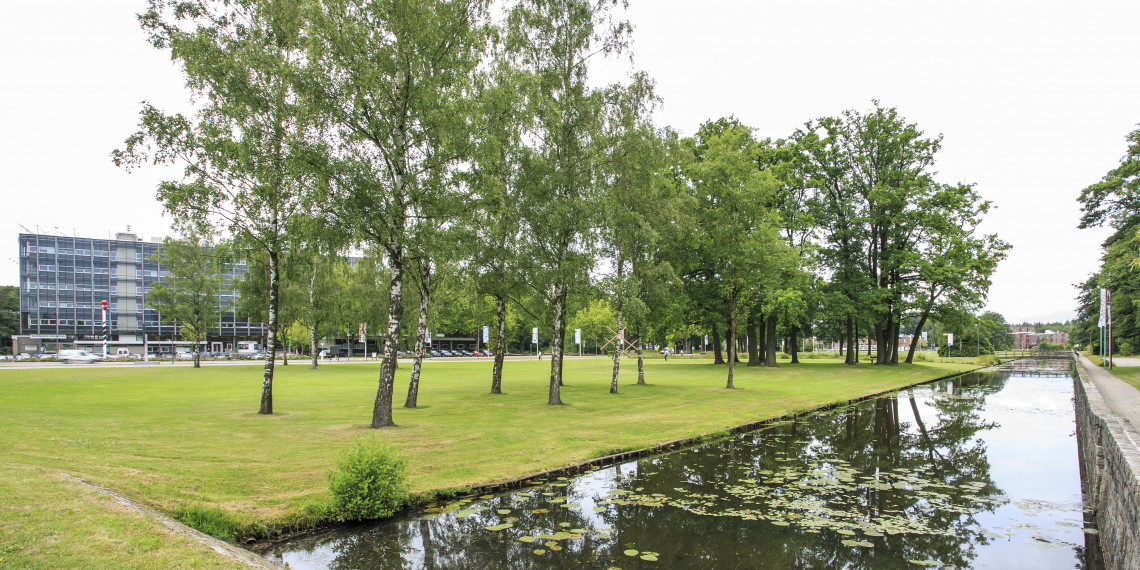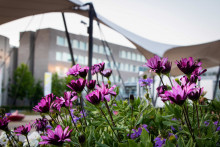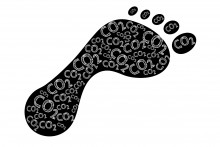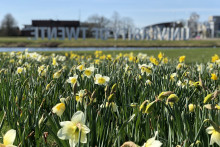A thorough method for examining the concept of sustainability is to look at your CO2 footprint. In the case of the UT, that was done quite recently. Last year the total CO2 emissions of the UT were 28596 tons, according to a report from Blonk Consultants. Do the math and you come to about two tons of CO2 per person. That is five times less than the average Dutch citizen, with the important footnote that the UT calculation naturally does not include the behavior of employees and students at home.
From the Blonk Consultants report: a breakdown of the UT's CO2 emissions last year.
‘Certainly not bad’
With that information in mind, Sustainability Policy Advisor Brechje Maréchal answers the question of how well we’re actually doing. ‘First of all, certainly not bad,’ she replies. 'In line with government objectives, we save two percent on our energy consumption every year. I find it difficult to draw a comparison with other universities, since technical universities have higher consumption anyway because of the research facilities.'
Different approach
To become more sustainable, the UT has recently opted for a different approach than in the past. When Maréchal applied for her position at the UT in 2018, she could not find much information about sustainability. 'I later spoke to colleagues about initiatives and it turned out that actually quite a lot can be classified as sustainable. But many initiatives are individual or fragmented, or are simply not written down because people don’t have the time or see it as a logical part of their work.’
That is why there is now a UT wide program, called SEE, for managing sustainability, energy and environmental performance. Maréchal: 'We are now working on a policy document to tackle sustainability in an integrated manner. We link that piece to the UT's strategy for the next three years.’
Sustainability week
The first ever UT Sustainability Week is currently taking place. Within this initiative, the UT organises all kinds of events to make sustainability visible and to inspire people for a sustainable future.
Misunderstandings
According to Maréchal, the whole concept of sustainability is so broad and complex, it’s quite logical that people can misunderstand certain choices. For example, those who are annoyed by the lighting in the Horst tower late at night, are not immediately right. 'Lighting is on late in the evening for safety reasons. To make escape routes visible for people who are still working,’ says Maréchal, to illustrate that quick fixes aren’t that easy to find. ’All in all, you have to look very carefully at measures that have an impact and measures that are visible.’
Maréchal calls the campus clean up organized by the association Sustain a fine example of a visible initiative. 'That helps enormously to get people involved. But of course, it's not just about visibility.’ Impact is, according to Maréchal, usually a different story: instead of worrying about the night-time lighting in the Horst tower, the UT can save more energy by arranging energy systems better in the buildings and looking at savings for large consumers. 'A subtle efficiency boost in the NanoLab for example, with a consumption of 4 million kilowatt hours of electricity last year, can make a big difference. Also the cooling circle at the Horst is not just an 'ugly bowl of water', as I hear many people say, but a sustainable way to cool all the buildings around it. And even though you don't see them, there are solar panels on the recently renovated Technohal.’
Maréchal has another example ready. 'Something that has already been done, but few people notice, is the placement of semi-underground containers as a replacement for garbage cans. Because garbage trucks now have to drive less often, CO2 emissions are reduced.'

Brechje Maréchal. Photo by Rikkert Harink.
Energy labels
Despite positive steps, Maréchal also sees enough ifs and buts on the road towards a more sustainable UT. Take, for example, the energy labels of buildings, where A ++ stands for 'a very energy-efficient' and G for 'a very inefficient building'. The Cubicus (built in 1973) received energy label A last year. With the important comment in the report that the building is connected to district heating (with a quality declaration), generated from biomass. Without that district heating, the Cubicus would have received energy label E. The same principle applies to the Spiegel, which got an A instead of an F. The Paviljoen, in which Maréchal herself works at the Campus & Facility Management department, even receives energy label G. 'The government aims for a maximum energy label C for office buildings. In the case of the Paviljoen you have to weigh what sustainability measures you want to take or if you might have to give the building a different function.’
The UT doesn’t have all matters in its own hands. A lot of work is outsourced, such as catering, waste processing, landscaping and cleaning. ’With current contractors, we have to find a way to implement improvements,’ says Maréchal. 'We will continue to work on that together. For example, Appèl recently opened a vegetarian location in the Technohal. And our partners are happily open to questions and comments. That is why the four major contractors were at the Sustainability Market in the Technohal today.’
Air travel
It is not only external parties who can take steps. It also applies to UT staff and students themselves. 'What people eat is very visible. If you eat chicken instead of red meat, that already makes a difference,’ says Maréchal.
What is also striking about the behavior of UT staff is business traffic. All our flight journeys are responsible for around 4000 tonnes of CO2 emissions. ‘I understand the need to travel,’ said Marechal. 'Research is by definition an international phenomenon, used to propel your research through new collaborations and in this way reel in grants. Sometimes you need face to face contact for that. But maybe you can consider skipping some appointments or communicate through Skype more? Or use another means of transport for a work trip?’
‘Always more, always better’
In the end, measuring is knowing to make ourselves more sustainable, says Maréchal. ‘We do that through the SEE program. We will soon have a new policy that we can fall back on.’Maréchal will have to wait and see how ambitious that policy will be. But she is certain that the topic is close to the heart of many people. She is also certain about the notion that there is still enough work to be done. ‘Especially when it comes to sustainability: we can always do more and always do better.’








